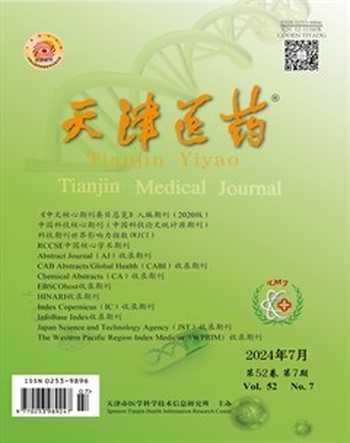结缔组织病相关间质性肺病:从发病机制研究到“双达标”治疗策略
李梦涛 王迁

作者单位:中国医学科学院北京协和医院风湿免疫科,国家皮肤与免疫疾病临床医学研究中心(邮编100730)
编者按:结缔组织病(CTD)是一组异质性风湿病,发病机制复杂,自身免疫、炎症、纤维化和内皮功能障碍等均发挥重要作用,临床表现为多系统、多器官受累。间质性肺病(ILD)是以肺间质炎症和纤维化为主要表现的弥漫性实质性肺疾病,导致气体交换障碍,患者表现为干咳、运动耐力下降、进行性呼吸困难、呼吸衰竭甚至死亡。肺动脉高压(PAH)是由已知/未知原因引起的肺血管结构和(或)功能改变所致肺血管阻力增加和肺动脉压力升高的病理状态,导致患者呼吸困难、右心衰竭甚至死亡。ILD和PAH均显著增加CTD患者的疾病负担并影响患者预后。我受《天津医药》编辑部邀约,特组织国内CTD相关肺受累研究领域的知名专家共同就CTD-ILD/PAH研究进展及临床关注问题进行阐述,专题文章内容包括CTD-ILD“双达标”治疗策略、自身抗体在CTD-ILD中的临床意义、CTD-ILD的动物模型研究进展、CTD-ILD合并COVID-19感染及肺癌的临床分析;心脏磁共振在CTD-PAH中的应用、MCTD-PAH临床特征等。以期加强各学科同道对CTD-ILD/PAH的认识,促进基础研究领域与临床医生对CTD-ILD/PAH的共同关注,并对该领域亟待解决的关键问题进行深入讨论,推动CTD-ILD/PAH的发病机制与临床诊疗的研究进展。最后,本人对参与和支持本专题工作的全体作者和编审专家所付出的辛勤工作表示由衷感谢!
魏蔚(专题主编)
作者简介:李梦涛(1972),男,教授,主任医师,博士研究生/博士后导师,全国著名风湿免疫学专家。北京协和医院风湿免疫科主任,协和学者特聘教授。国家卫生健康突出贡献中青年专家,北京医学会风湿病学分会主任委员,中华医学会风湿病学分会副主任委员,中国医师协会风湿免疫科医师分会副会长兼肺血管/间质病学组组长,国家风湿病数据中心(CRDC)及中国风湿免疫病医联体联盟(CRCA)秘书长,国家皮肤与免疫疾病临床医学研究中心(NCRC-DID)办公室主任,风湿免疫病学教育部重点实验室主任。《Rheumatology and Immunology Research(RIR)》副主编。系统性红斑狼疮研究国家十四五重点研发计划项目首席专家,十三五重点研发计划、首都协同创新重点项目及国自然课题负责人。E-mail:mengtao.li@cstar.org.cn
摘要:结缔组织病(CTD)是一类多器官系统受累的异质性疾病,间质性肺病(ILD)是多种CTD的严重并发症。不同CTD-ILD在发病机制、临床表现、治疗等方面存在较大异质性。基于遗传学、病理生理与免疫学、蛋白质组学、微生物组学进行相关基础及临床研究来探究CTD-ILD发病机制并提出“双达标”治疗策略。影像学技术及血清生物标志物研究的进展同时助力“双达标”治疗策略的实施,早期控制CTD活动与肺部炎症、延缓肺纤维化有利于改善CTD-ILD患者生存期与生活质量。
关键词:结缔组织疾病;肺疾病,间质性;诊断;治疗;发病机制
中图分类号:R593.2文献标志码:A DOI:10.11958/20240260
Connective tissue disease-associated interstitial lung disease: from pathogenesis to
"dual-target" treatment strategies
LI Mengtao, WANG Qian
Department of Rheumatology and Clinical Immunology, Peking Union Medical College Hospital, Chinese Academy of
Medical Sciences, Peking Union Medical College; National Clinical Research Center for Dermatologic and
Immunologic Diseases (NCRC-DID), Beijing 100730, China
Abstract: Connective tissue diseases (CTD) are a spectrum of heterogeneous diseases with multiple organ involvements. Interstitial lung diseases (ILD) are serious complications of CTD. There is great heterogeneity in pathogenesis, clinical manifestations, and treatment of different CTD-ILD. Previous basic and clinical studies have explored the pathogenesis of CTD-ILD, and the "dual-target" treatment strategy has therefore emerged. The implementation of the "dual-target" treatment strategy helps to control CTD activity and lung inflammation in the early stage, prevent the progression of pulmonary fibrosis, and thus improve patient survival and quality of life.
Key words: connective tissue diseases; lung diseases, interstitial; diagnosis; therapy; pathogenesis
结缔组织病(connective tissue diseases,CTD)是一组累及皮肤、肌肉、骨关节及重要脏器的异质性疾病。间质性肺病(interstitial lung diseases,ILD)是系统性硬化症(systemic sclerosis,SSc)、类风湿关节炎(rheumatoid arthritis,RA)、干燥综合征(Sjogren's syndrome,SS)、炎性肌病(idiopathic inflammatory myopathy,IIM)、混合性结缔组织病(mixed connective tissue diseases,MCTD)、系统性红斑狼疮(systemic lupus erythematosus,SLE)等CTD的严重并发症。不同结缔组织病相关间质性肺病(CTD-ILD)在发病机制、临床表现、治疗方法等存在较大异质性[1-2]。研究显示,不同CTD中合并ILD的比例差别很大,其中SSc为47%,IIM为41%,SS为17%,RA为11%,SLE为6%,MCTD为56%[3]。近年来,随着对CTD-ILD发病机制研究的不断深入,推进了CTD-ILD“双达标”治疗策略的建立[4]。早期控制CTD病情活动与肺部炎症,阻止肺纤维化进展,制定个性化的评估、治疗方案,均有助于改善CTD-ILD患者的预后。
1 CTD-ILD发病机制
1.1 遗传学 与CTD-ILD相关的基因变异包括黏蛋白5B基因(RA-ILD)和Toll作用蛋白基因(RA-ILD和SSc-ILD),RA-ILD和特发性肺纤维化患者具有重叠的遗传特征[5]。41.4%的CTD-ILD患者存在白细胞端粒长度缩短[6]。端粒酶复合体的功能丧失可在ILD发病之初影响肺泡上皮细胞的更新和愈合,从而诱发纤维化加重。临床前研究亦表明端粒酶激活剂对治疗ILD有一定效果[7]。
1.2 病理生理与免疫学机制 ILD的基本病理特征为肺泡上皮不断损伤和修复,肺实质由纤维化结缔组织替代,肺功能进行性丧失。纤维化结缔组织中主要细胞成分是分泌胶原的肌成纤维细胞[7]。CTD-ILD中固有免疫和适应性免疫异常是导致ILD发生发展的重要机制。目前已知CTD-ILD患者肺组织中巨噬细胞增多,减少巨噬细胞可显著减少成纤维细胞和胶原沉积,改善肺纤维化。巨噬细胞分泌的蛋白和miRNA也可调节肺纤维化过程[8]。SSc-ILD患者血液中的单核细胞可被募集到肺内并分化为肌成纤维细胞,而肌成纤维细胞是CTD-ILD发病中的关键细胞[7]。中性粒细胞的释放可影响细胞外基质,导致肺纤维化和肺修复异常。此外,中性粒细胞被微生物激活后可释放DNA、组蛋白和抗菌肽,形成中性粒细胞胞外诱捕网(neutrophil extracellular traps,NETs)。NETs可激活肺成纤维细胞并促进其分化为肌成纤维细胞[6]。T细胞、B细胞均参与CTD-ILD的发生。肺T淋巴细胞可通过细胞表面的相互作用调节纤维化,从而导致成纤维细胞活化和增殖以及细胞外基质中胶原沉积的增加。此外,SSc-ILD、RA-ILD和IIM患者的支气管肺泡灌洗液中T细胞升高,以细胞毒性CD8+T细胞为主。SSc-ILD中存在广泛的B细胞浸润,通过细胞因子诱导巨噬细胞极化,驱动间质纤维化[6-7]。
转化生长因子-β(transforming growth factor-β,TGF-β)通路、Toll样受体(toll-like receptor,TLR)通路、环状GMP-AMP合酶-干扰素基因刺激因子(cGAS-STING)与Ⅰ型干扰素通路、Janus激酶/信号转导子和转录激活子(JAK/STAT)通路、凋亡-焦亡-铁死亡通路也与CTD-ILD发病相关,这些途径可相互协同或拮抗导致肺纤维化,已成为近年的研究热点[5-6]。
1.3 蛋白质组学研究 近十年来蛋白质组学的应用揭示了多种蛋白质通过不同途径参与CTD-ILD各亚型的发病,为研究病理机制和临床生物标志物提供了新的思路。不同的CTD-ILD亚型具有不同的蛋白质组学变化:RA-ILD中主要的差异表达蛋白包括配对免疫球蛋白样2型受体相关神经蛋白、分泌型白细胞肽酶抑制剂、C-凝溶胶蛋白、N-凝溶胶蛋白、表面活性蛋白(surfactant associated protein,SP)-D;SSc-ILD中包括谷胱甘肽S-转移酶P、14-3-3、转甲状腺素蛋白、S100A8/钙卫蛋白、趋化因子CXC配体(chemokine C-X-C ligand,CXCL)4、线粒体编码ATP合酶6、钙粒蛋白、SP-D;IIM-ILD中包括FC-聚糖半乳糖化IgG、凝溶胶蛋白、钙粒蛋白、SP-D。在此基础上,已建立多维诊断或发病预测模型,敏感度、特异度可高达近85%[9]。
1.4 微生物组学研究 微生物群对免疫介导疾病的发生、发展具有重要作用,其与ILD的严重程度和预后相关。与健康对照相比,RA患者肺泡灌洗液中微生物群的多样性和丰度显著降低,且与疾病严重程度相关[10]。在SSc中,胃肠道微生物失调与ILD相关[11];动物模型中,丁酸通过恢复肠道菌群降低了肺纤维化程度[12]。但仍需更多CTD-ILD肺部微生物组学研究,以更好地了解CTD-ILD的发病机制[13]。
2 CTD-ILD的诊断与评估
2.1 高分辨率CT(HRCT) HRCT作为早期肺部炎症和纤维化改变及后期监测的金标准,一直是CTD-ILD诊断与病情监测的重要手段。HRCT可鉴别不同病理分型和分期的CTD-ILD[14]。寻常型间质性肺炎(usual interstitial pneumonia,UIP)是RA中最常见的ILD(约占46%),35%~45%的患者会出现CT影像学上的进展;而非特异性间质性肺炎(nonspecific interstitial pneumonia,NSIP)是所有其他CTD亚型中最常见的ILD(27%~76%)。淋巴细胞性间质性肺炎(lymphocytic interstitial pneumonia,LIP)在原发性SS中更常见,机化性肺炎(organizing pneumonia,OP)多见于IIM中,上述后2种ILD在其他CTD中较为少见[3]。纤维化性ILD是SSc-ILD的常见表现,主要累及肺基底部[14]。基线HRCT显示的纤维化程度(包括网状影、牵拉性支气管扩张和蜂窝影)与CTD-ILD各亚型的预后不良有关[15]。建议CTD-ILD患者每3~6个月就诊1次,检查肺功能的同时采用HRCT监测病情及对治疗的反应[14]。
以HRCT为基础的影像组学在ILD亚型分型和预后预测中具有巨大潜力。SSc-ILD相关研究提示,机器评估相较于人工判读在检测纤维化方面准确性更佳,机器学习可以预测患者疾病分期及预后[16]。定量肺纤维化评分也可预测RA-ILD患者的5年生存情况[17]。此外,机器学习有望辅助鉴别CTD-ILD和特发性肺纤维化。
2.2 新型影像评估技术 肺超声技术(lung ultrasound,LUS)在CTD-ILD中的应用逐渐增多。既往研究表明,肺超声中B线对SSc-、RA-、SS-、抗合成酶综合征-ILD等CTD-ILD具有较高的诊断准确性,且与HRCT表现具有良好的相关性,LUS可作为一种新型、无创影像学筛查方法[18-19]。另外,磁共振成像(MRI)也可鉴别肺部炎症和纤维化改变;但患者配合度及检查禁忌证等阻碍了MRI大规模应用于CTD-ILD[14]。近年来,正电子发射断层显像(positron emission computed tomography,PET)和单光子发射计算机断层显像(single-photon emission computed tomography,SPECT)已成为指导ILD个性化治疗的新兴分子成像技术。已有研究开始探索细胞凋亡、炎症、纤维化、细胞外基质形成等相关分子成像在CTD-ILD诊疗中的应用前景[20]。
2.3 CTD-ILD血清生物标志物 高滴度抗CCP抗体和类风湿因子阳性对RA-ILD有一定的预测价值。IIM患者抗组氨酰tRNA合成酶(Jo-1)、抗苏氨酰tRNA合成酶(PL-7)和抗丙氨酰tRNA合成酶(PL-12)等抗tRNA合成酶抗体阳性提示有较高的ILD发生风险;抗MDA-5抗体阳性IIM患者出现重症ILD风险增加,尤其在合并抗Ro-52阳性时[21]。另外,一些血清生物标志物,如涎液化糖链抗原6(KL-6)、SP-A、SP-D、趋化因子C-C基元配体(chemokine C-C motif ligand,CCL)1、CXCL9-11等可辅助CTD-ILD的诊断、严重程度评估与预后预测[22]。但上述生物标志物的临床应用尚不成熟,仍需更多临床研究寻找高特异性与敏感性的生物标志物,以预测ILD发生发展及病情分层。
2.4 支气管肺泡灌洗液和肺活检 明确肺泡灌洗液细胞增生程度和CTD-ILD的组织病理学特征有助于对疑难病例的诊断及对临床表型的病理机制评价[23]。但临床上仍不推荐支气管肺泡灌洗和肺活检作为CTD-ILD的常规诊断和评估手段,这些有创检查主要适用于排除肿瘤或淋巴增殖性肺疾病,以及对合并感染患者的病原学筛查等。
2.5 对进行性肺纤维化(progressive pulmonary fibrosis,PPF)亚型的鉴别 PPF作为CTD-ILD的危重亚型并不少见,而且由于其不可逆的纤维化进程,常提示预后不良。INBUILD研究中将PPF定义为尽管接受标准治疗(尼达尼布或吡非尼酮除外),24个月内仍出现以下情况中至少1项:用力肺活量(forced vital capacity,FVC)预计值下降≥10%;FVC预计值下降5%~<10%,伴呼吸道症状加重或胸部HRCT纤维化程度增加;呼吸道症状恶化同时伴HRCT提示纤维化程度增加。SSc-ILD[24]、局限皮肤型SSc-ILD、RA-ILD[25]、IIM-ILD[26]、SS-ILD[27]中PPF的比例分别为33%、19.9%、14%~40%、15.9%和28%。如何能更好地对这些病例进行早期预警和识别,对改善预后有重要意义。
3 CTD-ILD的治疗策略
3.1 治疗的启动时机 鉴于CTD-ILD的复杂性和难治性,仍需强调多学科诊疗(MDT)的协作模式[4],并需充分遵循卫生经济学原则,综合考虑客观医疗成本。随着对CTD-ILD发病机制认识的加深,“双达标”成为该病的最主要治疗理念。一方面是针对CTD的免疫抑制治疗,强调早期、规范化治疗的意义是在CTD-ILD的病情早期(肺功能相对正常),肺间质病变尚处于可逆阶段时,针对CTD的免疫抑制治疗,可以更有效地阻止乃至逆转ILD,从而最大程度地保留肺功能。另一方面是针对ILD和可能的PPF的抗纤维化治疗,临床上抗纤维化治疗的启动时机仍有争论,可参照呼吸科的标准,即患者临床表现加重,FVC较基线下降10%以上或FVC绝对值小于70%或FVC下降5%~<10%,同时肺一氧化碳弥散量(diffusing capacity of the lungs for carbon monoxide,DLCO)较基线下降15%以上,或CT提示病变面积超过肺总体积的20%[28-29]。
3.2 药物治疗原则
3.2.1 糖皮质激素的使用原则 糖皮质激素的使用取决于CTD原发病和肺外表现。多数SSc-ILD应避免使用大剂量糖皮质激素[30-31]。对于SSc-ILD以外的CTD-ILD患者,仍建议将糖皮质激素作为ILD的一线治疗,具体的初始用量需根据疾病严重程度和受累范围进行判定[32]。LIP和NSIP对糖皮质激素的反应优于UIP[28,30]。
3.2.2 免疫抑制剂、生物制剂和小分子药物的使用原则 由于疾病的异质性和机制的复杂性,目前仍缺乏公认的治疗指南和建议。对于CTD-ILD患者,霉酚酸盐、硫唑嘌呤、利妥昔单抗或环磷酰胺均可作为一线治疗方案[32-37]。对于IIM-ILD患者,也可推荐钙调磷酸酶抑制剂(calcinurin inhibitors,CNI)作为ILD的一线治疗方案,目前JAK抑制剂作为ILD一线治疗方案仍有争议[30,32]。有学者提出,在一些患者中可考虑托珠单抗作为ILD的一线治疗方案[30,38-39]。一般不将来氟米特、甲氨蝶呤、肿瘤坏死因子拮抗剂(tumor necrosis factor inhibitor,TNFi)和阿巴西普作为CTD-ILD的一线治疗方案[40-41]。对于首次ILD治疗后仍出现CTD-ILD进展的患者,可考虑换用霉酚酸酯、利妥昔单抗、环磷酰胺[30,36,42]。对于首次ILD治疗后仍发生IIM-ILD进展的患者,可考虑将CNI作为联合或替换治疗, 除IIM-ILD之外的其他CTD-ILD患者则不建议遵循上述原则[30]。对于首次治疗后仍出现CTD-ILD进展的患者,也可考虑使用托珠单抗或JAK抑制剂,但具体治疗策略仍有争议[42]。
3.2.3 抗纤维化药物的使用原则 对于SSc-ILD患者,尼达尼布可作为ILD的一线治疗方案[43-45];其余CTD-ILD尚无确切支持证据。对于CTD-ILD患者,吡非尼酮作为ILD的一线治疗方案的证据仍不足[30]。因此,临床上需根据ILD的纤维化程度,结合卫生经济学进行综合判断。
3.2.4 细胞治疗 对于进展迅速且无肺动脉高压的SSc-ILD患者,自体造血干细胞移植(autologous hematopoietic stem cell transplantation,AHSCT)有一定治疗作用[28]。但对于所有CTD-ILD患者,AHSCT或肺移植均不建议作为ILD的一线治疗方案[30]。靶向B细胞和浆母细胞的CD19的嵌合抗原受体T细胞免疫疗法与霉酚酸酯联合使用或可诱导难治性抗合成酶综合征缓解[46]。
3.3 非药物治疗 CTD-ILD的非药物治疗需要多学科共同努力。非药物疗法包括疫苗接种、肺康复训练、合并症管理、姑息治疗和氧疗、肺移植等[28]。对首次ILD治疗后仍出现SSc-ILD进展的患者,可考虑转诊接受肺移植[30,47]。
综上,CTD-ILD是一组共性与特性并存的疾病,临床表型复杂,诊断和治疗困难。只有推动基础和临床研究进展,深入剖析发病机制和病理生理过程,才能更好地完善CTD-ILD的诊断、评估与“双达标”治疗策略。
参考文献
[1] MIRA-AVENDANO I,ABRIL A,BURGER C D,et al. Interstitial lung disease and other pulmonary manifestations in connective tissue diseases[J]. Mayo Clin Proc,2019,94(2):309-325. doi:10.1016/j.mayocp.2018.09.002.
[2] MATHAI S C,DANOFF S K. Management of interstitial lung disease associated with connective tissue disease[J]. BMJ,2016,352:h6819. doi:10.1136/bmj.h6819.
[3] JOY G M,ARBIV O A,WONG C K,et al. Prevalence,imaging patterns and risk factors of interstitial lung disease in connective tissue disease:a systematic review and meta-analysis[J]. Eur Respir Rev,2023,32(167):220210. doi:10.1183/16000617.0210-2022.
[4] 中国医师协会风湿免疫科医师分会风湿病相关肺血管/间质病学组,国家风湿病数据中心. 2018中国结缔组织病相关间质性肺病诊断和治疗专家共识[J]. 中华内科杂志,2018,57(8):558-565. Rheumatology Related Pulmonary Vascular/Interstitial Epidemiology Group, Rheumatology and Immunology Division,Chinese Medical Doctor Association,National Rheumatology Data Center. 2018 Chinese expert-based consensus statement regarding the diagnosis and treatment of interstitial lung disease associated with connective tissue diseases[J]. Chin J Intern Med,2018,57(8):558-565. doi:10.3760/cma.j.issn.0578-1426.2018.08.005.
[5] SHAO T,SHI X,YANG S,et al. Interstitial lung disease in connective tissue disease: a common lesion with heterogeneous mechanisms and treatment considerations[J]. Front Immunol,2021,12:684699. doi:10.3389/fimmu.2021.684699.
[6] CERRO CHIANG G,PARIMON T. Understanding interstitial lung diseases associated with connective tissue disease(CTD-ILD):genetics,cellular pathophysiology,and biologic drivers[J]. Int J Mol Sci,2023,24(3):2405. doi:10.3390/ijms24032405.
[7] SPAGNOLO P,DISTLER O,RYERSON C J,et al. Mechanisms of progressive fibrosis in connective tissue disease (CTD)-associated interstitial lung diseases (ILDs)[J]. Ann Rheum Dis,2021,80(2):143-150. doi:10.1136/annrheumdis-2020-217230.
[8] TSENG C C,SUNG Y W,CHEN K Y,et al. The Role of Macrophages in connective tissue disease-associated interstitial lung disease: focusing on molecular mechanisms and potential treatment strategies[J]. Int J Mol Sci,2023,24(15):11995. doi:10.3390/ijms241511995.
[9] WU Y,LI Y,LUO Y,et al. Proteomics: potential techniques for discovering the pathogenesis of connective tissue diseases-interstitial lung disease[J]. Front Immunol,2023,14:1146904. doi:10.3389/fimmu.2023.1146904.
[10] SCHER J U,JOSHUA V,ARTACHO A,et al. The lung microbiota in early rheumatoid arthritis and autoimmunity[J]. Microbiome,2016,4(1):60. doi:10.1186/s40168-016-0206-x.
[11] ANDR?ASSON K,LEE S M,LAGISHETTY V,et al. Disease features and gastrointestinal microbial composition in patients with systemic sclerosis from two independent cohorts[J]. ACR Open Rheumatol,2022,4(5):417-425. doi:10.1002/acr2.11387.
[12] VERES-SZ?KELY A,SZ?SZ C,PAP D,et al. Zonulin as a potential therapeutic target in microbiota-gut-brain axis disorders: encouraging results and emerging questions[J]. Int J Mol Sci,2023,24(8):7548. doi:10.3390/ijms24087548.
[13] DRAKOPANAGIOTAKIS F,STAVROPOULOU E,TSIGALOU C,et al. The role of the microbiome in connective-tissue-associated interstitial lung disease and pulmonary vasculitis[J]. Biomedicines,2022,10(12):3195. doi:10.3390/biomedicines10123195.
[14] JEON H,NAM B D,YOON C H,et al. Radiologic approach and progressive exploration of connective tissue disease-related interstitial lung disease: meeting the curiosity of rheumatologists[J]. J Rheum Dis,2024,31(1):3-14. doi:10.4078/jrd.2023.0042.
[15] PUGASHETTI J V,KHANNA D,KAZEROONI E A,et al. Clinically relevant biomarkers in connective tissue disease-associated interstitial lung disease[J]. Immunol Allergy Clin North Am,2023,43(2):411-433. doi:10.1016/j.iac.2023.01.012.
[16] ANTHIMOPOULOS M,CHRISTODOULIDIS S,EBNER L,et al. Lung pattern classification for interstitial lung diseases using a deep convolutional neural network[J]. IEEE Trans Med Imaging,2016,35(5):1207-1216. doi:10.1109/TMI.2016.2535865.
[17] JACOB J,HIRANI N,VAN MOORSEL C,et al. Predicting outcomes in rheumatoid arthritis related interstitial lung disease[J]. Eur Respir J,2019,53(1):1800869. doi:10.1183/1399300 3.00869-2018.
[18] WANG Y,GARGANI L,BARSKOVA T,et al. Usefulness of lung ultrasound B-lines in connective tissue disease-associated interstitial lung disease:a literature review[J]. Arthritis Res Ther,2017,19(1):206. doi:10.1186/s13075-017-1409-7.
[19] WANG Y,CHEN S,ZHENG S,et al. The role of lung ultrasound B-lines and serum KL-6 in the screening and follow-up of rheumatoid arthritis patients for an identification of interstitial lung disease:review of the literature,proposal for a preliminary algorithm,and clinical application to cases[J]. Arthritis Res Ther,2021,23(1):212. doi:10.1186/s13075-021-02586-9.
[20] BROENS B,DUITMAN J W,ZWEZERIJNEN G,et al. Novel tracers for molecular imaging of interstitial lung disease:A state of the art review[J]. Autoimmun Rev,2022,21(12):103202. doi:10.1016/j.autrev.2022.103202.
[21] MARIE I,JOSSE S,DECAUX O,et al. Comparison of long-term outcome between anti-Jo1- and anti-PL7/PL12 positive patients with antisynthetase syndrome[J]. Autoimmun Rev,2012,11(10):739-745. doi:10.1016/j.autrev.2012.01.006.
[22] MI?DLIKOWSKA E,RZEPKA-WRONA P,MI?KOWSKA-DYMANOWSKA J,et al. Review:serum biomarkers of lung fibrosis in interstitial pneumonia with autoimmune features-what do we already know?[J]. J Clin Med,2021,11(1):89. doi:10.3390/jcm11010079.
[23] TOMASSETTI S,COLBY T V,WELLS A U,et al. Bronchoalveolar lavage and lung biopsy in connective tissue diseases,to do or not to do?[J]. Ther Adv Musculoskelet Dis,2021,13:1759720X211059605. doi:10.1177/1759720X211059605.
[24] JAEGER V K,WIRZ E G,ALLANORE Y,et al. Incidences and risk factors of organ manifestations in the early course of systemic sclerosis: a longitudinal eustar study[J]. PLoS One,2016,11(10):e0163894. doi:10.1371/journal.pone.0163894.
[25] ZAMORA-LEGOFF J A,KRAUSE M L,CROWSON C S,et al. Progressive decline of lung function in rheumatoid arthritis-associated interstitial lung disease[J]. Arthritis Rheumatol,2017,69(3):542-549. doi:10.1002/art.39971.
[26] MARIE I,HATRON P Y,DOMINIQUE S,et al. Short-term and long-term outcomes of interstitial lung disease in polymyositis and dermatomyositis: a series of 107 patients[J]. Arthritis Rheum,2011,63(11):3439-3447. doi:10.1002/art.30513.
[27] PARAMBIL J G,MYERS J L,LINDELL R M,et al. Interstitial lung disease in primary Sj?gren syndrome[J]. Chest,2006,130(5):1489-1495. doi:10.1378/chest.130.5.1489.
[28] AHMED S,HANDA R. Management of connective tissue disease-related interstitial lung disease[J]. Curr Pulmonol Rep,2022,11(3):86-98. doi:10.1007/s13665-022-00290-w.
[29] WILSON T M,SOLOMON J J,DEMORUELLE M K. Treatment approach to connective tissue disease-associated interstitial lung disease[J]. Curr Opin Pharmacol,2022,65:102245. doi:10.1016/j.coph.2022.102245.
[30] American College of Rheumatology Empowering Rheumatology Professionals. 2023 American College of Rheumatology(ACR)guideline for the treatment of interstitial lung disease in people with systemic autoimmune rheumatic disease[EB/OL]. (2023-08-23)[2024-03-06]. https://rheumatology.org/interstitial-lung-disease-guideline#2023-ild-guideline.
[31] BARNES H,HOLLAND A E,WESTALL G P,et al. Cyclophosphamide for connective tissue disease-associated interstitial lung disease[J]. Cochrane Database Syst Rev,2018,1(1):CD010908. doi:10.1002/14651858.CD010908.pub2.
[32] BARBA T,FORT R,COTTIN V,et al. Treatment of idiopathic inflammatory myositis associated interstitial lung disease:A systematic review and meta-analysis[J]. Autoimmun Rev,2019,18(2):113-122. doi:10.1016/j.autrev.2018.07.013.
[33] MATSON S M,BAQIR M,MOUA T,et al. Treatment outcomes for rheumatoid arthritis-associated interstitial lung disease: a real-world,multisite study of the impact of immunosuppression on pulmonary function trajectory[J]. Chest,2023,163(4):861-869. doi:10.1016/j.chest.2022.11.035.
[34] MAHER T M,TUDOR V A,SAUNDERS P,et al. Rituximab versus intravenous cyclophosphamide in patients with connective tissue disease-associated interstitial lung disease in the UK (RECITAL):a double-blind,double-dummy,randomised,controlled,phase 2b trial[J]. Lancet Respir Med,2023,11(1):45-54. doi:10.1016/S2213-2600(22)00359-9.
[35] ASSASSI S,VOLKMANN E R,ZHENG W J,et al. Peripheral blood gene expression profiling shows predictive significance for response to mycophenolate in systemic sclerosis-related interstitial lung disease[J]. Ann Rheum Dis,2022,81(6):854-860. doi:10.1136/annrheumdis-2021-221313.
[36] KARAKONTAKI F V,PANSELINAS E S,POLYCHRONOPOULOS V S,et al. Targeted therapies in interstitial lung disease secondary to systemic autoimmune rheumatic disease. Current status and future development[J]. Autoimmun Rev,2021,20(2):102742. doi:10.1016/j.autrev.2020.102742.
[37] HUAPAYA J A,SILHAN L,PINAL-FERNANDEZ I,et al. Long-term treatment with azathioprine and mycophenolate mofetil for myositis-related interstitial lung disease[J]. Chest,2019,156(5):896-906. doi:10.1016/j.chest.2019.05.023.
[38] KHANNA D,LIN C,FURST D E,et al. Long-term safety and efficacy of tocilizumab in early systemic sclerosis-interstitial lung disease: open-label extension of a phase 3 randomized controlled trial[J]. Am J Respir Crit Care Med,2022,205(6):674-684. doi:10.1164/rccm.202103-0714OC.
[39] ROOFEH D,LIN C,GOLDIN J,et al. Tocilizumab prevents progression of early systemic sclerosis-associated interstitial lung disease[J]. Arthritis Rheumatol,2021,73(7):1301-1310. doi:10.1002/art.41668.
[40] VICENTE-RABANEDA E F,ATIENZA-MATEO B,BLANCO R,et al. Efficacy and safety of abatacept in interstitial lung disease of rheumatoid arthritis:A systematic literature review[J]. Autoimmun Rev,2021,20(6):102830. doi:10.1016/j.autrev.2021.102830.
[41] BELLAN M,PATRUCCO F,BARONE-ADESI F,et al. Targeting CD20 in the treatment of interstitial lung diseases related to connective tissue diseases:A systematic review[J]. Autoimmun Rev,2020,19(2):102453. doi:10.1016/j.autrev.2019.102453.
[42] KHANNA D,LESCOAT A,ROOFEH D,et al. Systemic sclerosis-associated interstitial lung disease: how to incorporate two food and drug administration-approved therapies in clinical practice[J]. Arthritis Rheumatol,2022,74(1):13-27. doi:10.1002/art.41933.
[43] HIGHLAND K B,DISTLER O,KUWANA M,et al. Efficacy and safety of nintedanib in patients with systemic sclerosis-associated interstitial lung disease treated with mycophenolate:a subgroup analysis of the SENSCIS trial[J]. Lancet Respir Med,2021,9(1):96-106. doi:10.1016/S2213-2600(20)30330-1.
[44] SEIBOLD J R,MAHER T M,HIGHLAND K B,et al. Safety and tolerability of nintedanib in patients with systemic sclerosis-associated interstitial lung disease:data from the SENSCIS trial[J]. Ann Rheum Dis,2020,79(11):1478-1484. doi:10.1136/annrheumdis-2020-217331.
[45] DISTLER O,HIGHLAND K B,GAHLEMANN M,et al. Nintedanib for systemic sclerosis-associated interstitial lung disease[J]. N Engl J Med,2019,380(26):2518-2528. doi:10.1056/NEJMoa1903076.
[46] PECHER A C,HENSEN L,KLEIN R,et al. CD19-targeting CAR T cells for myositis and interstitial lung disease associated with antisynthetase syndrome[J]. JAMA,2023,329(24):2154-2162. doi:10.1001/jama.2023.8753.
[47] PERELAS A,SILVER R M,ARROSSI A V,et al. Systemic sclerosis-associated interstitial lung disease[J]. Lancet Respir Med,2020,8(3):304-320. doi:10.1016/S2213-2600(19)30480-1.
(2024-03-06收稿 2024-04-17修回)
(本文编辑 胡小宁)

